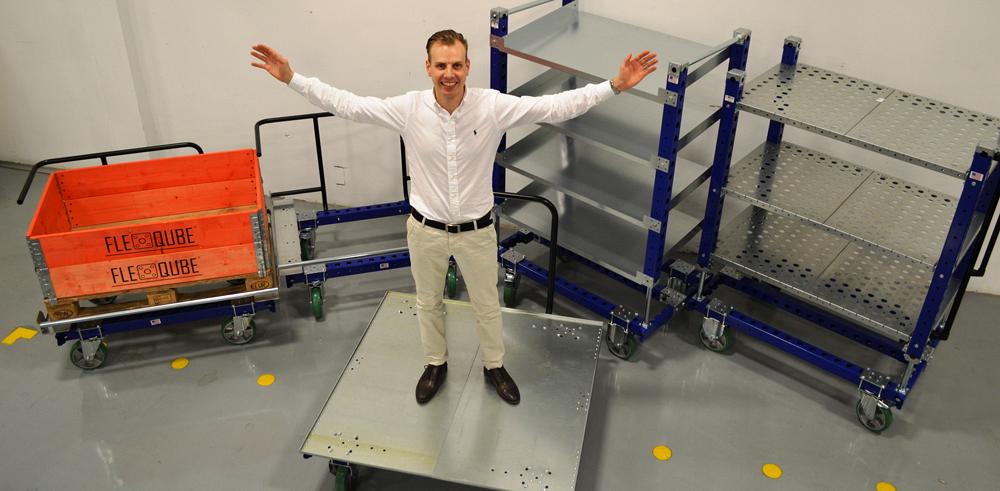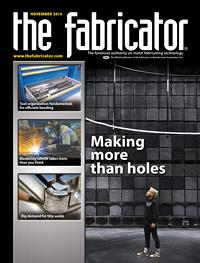Senior Editor
- FMA
- The Fabricator
- FABTECH
- Canadian Metalworking
Categories
- Additive Manufacturing
- Aluminum Welding
- Arc Welding
- Assembly and Joining
- Automation and Robotics
- Bending and Forming
- Consumables
- Cutting and Weld Prep
- Electric Vehicles
- En Español
- Finishing
- Hydroforming
- Laser Cutting
- Laser Welding
- Machining
- Manufacturing Software
- Materials Handling
- Metals/Materials
- Oxyfuel Cutting
- Plasma Cutting
- Power Tools
- Punching and Other Holemaking
- Roll Forming
- Safety
- Sawing
- Shearing
- Shop Management
- Testing and Measuring
- Tube and Pipe Fabrication
- Tube and Pipe Production
- Waterjet Cutting
Industry Directory
Webcasts
Podcasts
FAB 40
Advertise
Subscribe
Account Login
Search
The Erector set meets the material handling cart
Modular system adapts to the application
- By Tim Heston
- November 10, 2014
- Article
- Materials Handling

In 2011 CEO Anders Fogelberg launched FlexQube with two friends in Sweden. The company opened U.S. operations in 2013.
Several years ago a onetime plant engineer, Per Augustsson, was having similar thoughts. He worked at an automotive OEM plant that was using a modular cart system, but it wasn’t ideal. It had myriad parts that weren’t standardized, and it carried only light components, nothing too heavy.
Augustsson knew Anders Fogelberg, who worked as an Accenture consultant and had previously launched an investment company, so he knew the basics about getting a business off the ground. Augustsson also knew Fogelberg’s longtime friend Christian Thiel. When the three got to talking, they realized they may be on to something.
Growing up in 1980s Sweden, all three played with LEGO®s and Erector® sets. The creations you can make with either are endless, but the assembly method is pretty much standardized. The blocks and beams click or lock together in specific ways and (for the Erector set) with certain tools. Why, they asked, couldn’t a similar concept apply to material handling carts in a factory?
In 2011 the three launched FlexQube AB, with Fogelberg as CEO, Augustsson as chief technology officer, and Thiel as CFO. The company sells a modular way to make carts that are suitable for moving a variety of tools and parts, from thin-gauge sheets to heavy weldments. Carts consist of standard components, including a cube (hence the company name) that forms the connection point for holding structural tubes and crossbeams.
To keep things standard and simple, all components are bolted in place using M6 threads, and every possible dimension divides by 7. The cube connection is 7 by 7 cm, and tube and beams come in lengths divisible by 7. The company has design guidelines on its website, as well as a CAD library of standard components.
Carts can be adapted to carry different components or to be pushed or pulled in a different way for better worker ergonomics. For instance, a cart can be designed so that the operator can adjust the handle up or down.
Some have used the system not only as a material handling cart, but also as an assembly station. Such a system, Fogelberg said, has helped overcome a common conundrum for high-product-mix manufacturers: How do you standardize assembly when one product is entirely different from the next?
Imagine a situation in which operators fabricate parts and place them on a customized cart designed to carry a specific kit, along with all the tools necessary to put that kit together. After fabrication, they roll the cart to assembly, where workers pull out a leaf and fold down legs that extend to the floor. This transforms the cart into an assembly table customized for the product it’s carrying.
The company’s main growth strategy has been to sell to major OEMs, many of which are reducing their fork truck usage in favor of tugger systems. In many environments, fork trucks, tuggers, and carts work together. A heavy load is placed on a cart with a fork truck, and that cart is pulled to its destination with a tugger.

In 2011 CEO Anders Fogelberg launched FlexQube with two friends in Sweden. The company opened U.S. operations in 2013.
The carts also can be used with what Fogelberg calls a “mother-daughter” arrangement. One version of this arrangement has been developed and refined by German company LR Intralogistik, which distributes in the U.S. through Linde Material Handling.
It entails a “mother” E-frame tugger cart carrying a “daughter” FlexQube cart. The daughter cart can be rolled over the mother E-frame cart (which, as you can guess, looks like an uppercase E) and is locked in place. The mother cart’s platform rises far enough so the daughter cart’s wheels are off the ground. When the tugger train arrives to its destination, the mother cart lowers, allowing workers to slide off the FlexQube cart and wheel it to wherever it needs to go.
Last year FlexQube began manufacturing and distributing cart components stateside. “If you start to look at how many carts and racks are used in U.S. manufacturing companies, you get a huge number,” Fogelberg said.
He added that most European manufacturers outsource their cart production to area fabricators, while more U.S. OEMs and their suppliers tend to fabricate custom material handling carts themselves. But what if an OEM used the same cart system at every plant—not just for facilities in the U.S., but everywhere?
“They can implement the exact same cart system around the globe,” Fogelberg said. “If an OEM chooses to shut down a plant in Asia and move production to the U.S., it can transfer the carts along with everything else.”
Photo courtesy of FlexQube Inc.
About the Author

Tim Heston
2135 Point Blvd
Elgin, IL 60123
815-381-1314
Tim Heston, The Fabricator's senior editor, has covered the metal fabrication industry since 1998, starting his career at the American Welding Society's Welding Journal. Since then he has covered the full range of metal fabrication processes, from stamping, bending, and cutting to grinding and polishing. He joined The Fabricator's staff in October 2007.
subscribe now

The Fabricator is North America's leading magazine for the metal forming and fabricating industry. The magazine delivers the news, technical articles, and case histories that enable fabricators to do their jobs more efficiently. The Fabricator has served the industry since 1970.
start your free subscription- Stay connected from anywhere

Easily access valuable industry resources now with full access to the digital edition of The Fabricator.

Easily access valuable industry resources now with full access to the digital edition of The Welder.

Easily access valuable industry resources now with full access to the digital edition of The Tube and Pipe Journal.
- Podcasting
- Podcast:
- The Fabricator Podcast
- Published:
- 04/30/2024
- Running Time:
- 53:00
Seth Feldman of Iowa-based Wertzbaugher Services joins The Fabricator Podcast to offer his take as a Gen Zer...
- Trending Articles
JM Steel triples capacity for solar energy projects at Pennsylvania facility

Fabricating favorite childhood memories

How laser and TIG welding coexist in the modern job shop

Robotic welding sets up small-batch manufacturer for future growth

Ultra Tool and Manufacturing adds 2D laser system

- Industry Events
Pipe and Tube Conference
- May 21 - 22, 2024
- Omaha, NE
World-Class Roll Forming Workshop
- June 5 - 6, 2024
- Louisville, KY
Advanced Laser Application Workshop
- June 25 - 27, 2024
- Novi, MI
Precision Press Brake Certificate Course
- July 31 - August 1, 2024
- Elgin,


























